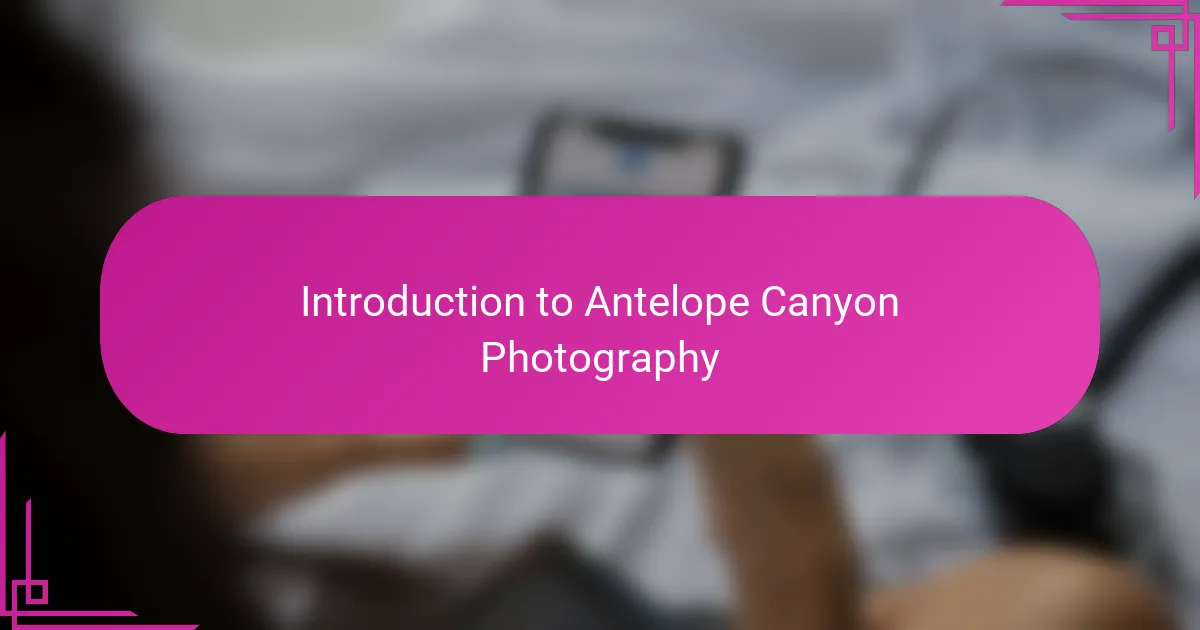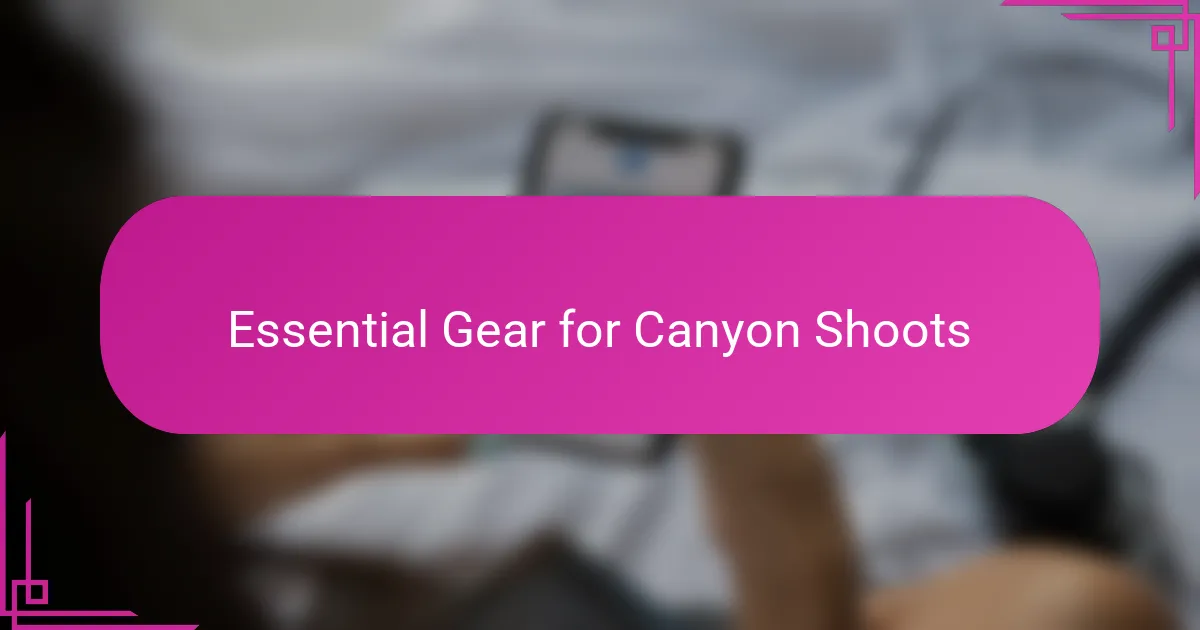Key takeaways
- Antelope Canyon offers unique photographic opportunities with its vibrant colors and intricate textures, enhanced by proper gear such as a tripod and wide-angle lens.
- Understanding lighting conditions is crucial; timing your shots during early morning or late afternoon helps capture softer light, while midday reveals dramatic beams.
- Effective composition in tight spaces includes focusing on leading lines and minimalism, allowing the natural shapes of the canyon to guide the viewer’s eye.
- Post-processing is essential to balance shadows and highlights, requiring careful techniques to maintain the canyon’s natural beauty without overpowering the images.

Introduction to Antelope Canyon Photography
Antelope Canyon is a photographer’s dream, with its swirling sandstone walls and shafts of light that seem almost otherworldly. When I first stepped into this natural masterpiece, I was overwhelmed by the vibrant colors and intricate textures that change with every step. Have you ever been somewhere that feels like it was crafted just for your camera? That’s exactly how Antelope Canyon feels to me.

Essential Gear for Canyon Shoots
When I prepared for my shoot in Antelope Canyon, the first thing I packed was a sturdy tripod. The canyon’s low light and long exposures demand stability, and nothing ruined a photo faster for me than a shaky camera. Have you ever tried handheld shooting in dim light only to end up with blurry shots? A tripod quickly became my best friend there.
Another must-have for me was a wide-angle lens. The tight curves and towering walls can’t be fully captured with a standard lens, and I found that the wider perspective really enhanced the sense of depth and scale. I remember struggling with a zoom lens at first, feeling cramped, until I switched lenses and suddenly the canyon’s grandeur popped right off the screen.
Lastly, I never leave without lens cleaning tools. Dust and sand are unavoidable in such a dry, windy place, and I learned the hard way after a handful of spoiled shots from smudges. Keeping my gear clean felt like a small but critical act of respect toward the environment and my craft—it made all the difference in the clarity of my images.

Understanding Lighting Conditions
Lighting in Antelope Canyon is unlike anywhere else I’ve experienced. The way sunlight filters through narrow openings creates dramatic beams that shift and dance throughout the day. Have you ever stood still, watching light carve shapes on a wall? That moment felt almost magical to me.
I quickly realized that understanding the timing was crucial. Early morning or late afternoon brought softer, more diffuse light, while midday offered those intense, almost surreal light shafts everyone talks about. I found myself constantly checking the clock, eager to catch the perfect glow that would transform the canyon’s textures into something ethereal.
One tricky part was dealing with the high contrast between bright light beams and deep shadows. Capturing detail in both wasn’t easy, and I had to experiment with exposure settings and bracketing more than once. It made me appreciate how unpredictable natural light can be, and how important it is to adapt on the fly while staying patient.

Composition Tips in Narrow Spaces
Shooting in tight spots like Antelope Canyon really tests your eye for composition. I found that focusing on simple lines and shapes helped me avoid cluttered frames. Have you ever struggled to fit everything in yet keep the image balanced? Leaning into minimalism was my solution—it let the canyon’s natural curves do the storytelling.
One trick I swear by is using leading lines to draw the viewer’s eye deeper into the photo. The canyon walls twist and fold, almost like nature’s ribbons, guiding your gaze through the scene. At first, I missed these subtle guides, but once I noticed them, my shots instantly gained more impact and flow.
It can be tempting to zoom out and take it all in, but sometimes zooming in on smaller textures creates a stronger impression. I caught myself capturing intricate patterns of light and shadow that told a more intimate story. Narrow spaces push you to look closer, and honestly, that’s where I found some of my most memorable images.

Challenges Encountered During Shooting
Shooting in Antelope Canyon wasn’t without its headaches. The narrow walkways meant I often jostled with other photographers, which made setting up my tripod a test of patience. Have you ever tried to compose a shot while feeling like you’re in a traffic jam? That’s exactly how it felt at times.
Then there was the constant battle against shifting light. Just as I’d dial in the perfect exposure, the sunbeam would move or disappear altogether, forcing me to rethink angles on the fly. It felt like chasing a ghost, but those fleeting moments made the wait worthwhile.
Dust was another sneaky adversary. Despite my careful lens cleaning, tiny particles seemed to cling to every surface, threatening to blur what could have been sharp, crisp images. I quickly learned to carry extra cloths and stay vigilant, because in such a delicate environment, every speck mattered.

Personal Experience and Techniques
Navigating Antelope Canyon with my camera felt like solving a puzzle every few steps. I relied heavily on slow shutter speeds to capture the subtle light beams, which meant grounding myself behind the tripod and patiently waiting for just the right moment. Have you ever felt that mix of anticipation and calm, knowing that one perfect shot could emerge from the chaos of shifting light? That patience truly became my strongest technique.
I also found that bracketing exposures was a lifesaver when facing the canyon’s extreme contrasts. At first, I hesitated—was it worth the extra effort? But blending multiple shots later revealed a richness in detail I couldn’t achieve otherwise. It turned the challenge of harsh lighting into an opportunity to deepen the story my photos could tell.
One unexpected lesson was how much walking and repositioning changed my perspective. Rather than settling for obvious angles, I constantly moved along the canyon’s curves, crouching or stretching to find unique viewpoints. This kept me engaged and reminded me that in a place like this, creativity thrives when you don’t just stand still.

Post-Processing Antelope Photos
Post-processing Antelope photos became as much a part of my creative journey as the shoot itself. Have you ever opened your images and realized that the raw files, while full of potential, needed a bit more love to truly reflect what you experienced? For me, adjusting contrast and boosting vibrance gently helped recreate the canyon’s warmth and depth without losing its natural feel.
One challenge I faced was balancing the intense shadows with the bright shafts of light. It took some careful dodging and burning—techniques that let me selectively lighten or darken areas—to keep details from disappearing into blacks or blowing out in highlights. This fine-tuning felt like bringing a fragile painting to life, preserving the mood I’d felt standing inside those swirling walls.
I also learned that subtle sharpening and noise reduction go hand in hand when working with low-light shots from the canyon. Overdoing either can ruin the delicate textures carved by centuries of erosion. Patience and restraint became my best tools during editing, reminding me that the goal was to enhance, not overpower, the already stunning natural artistry.